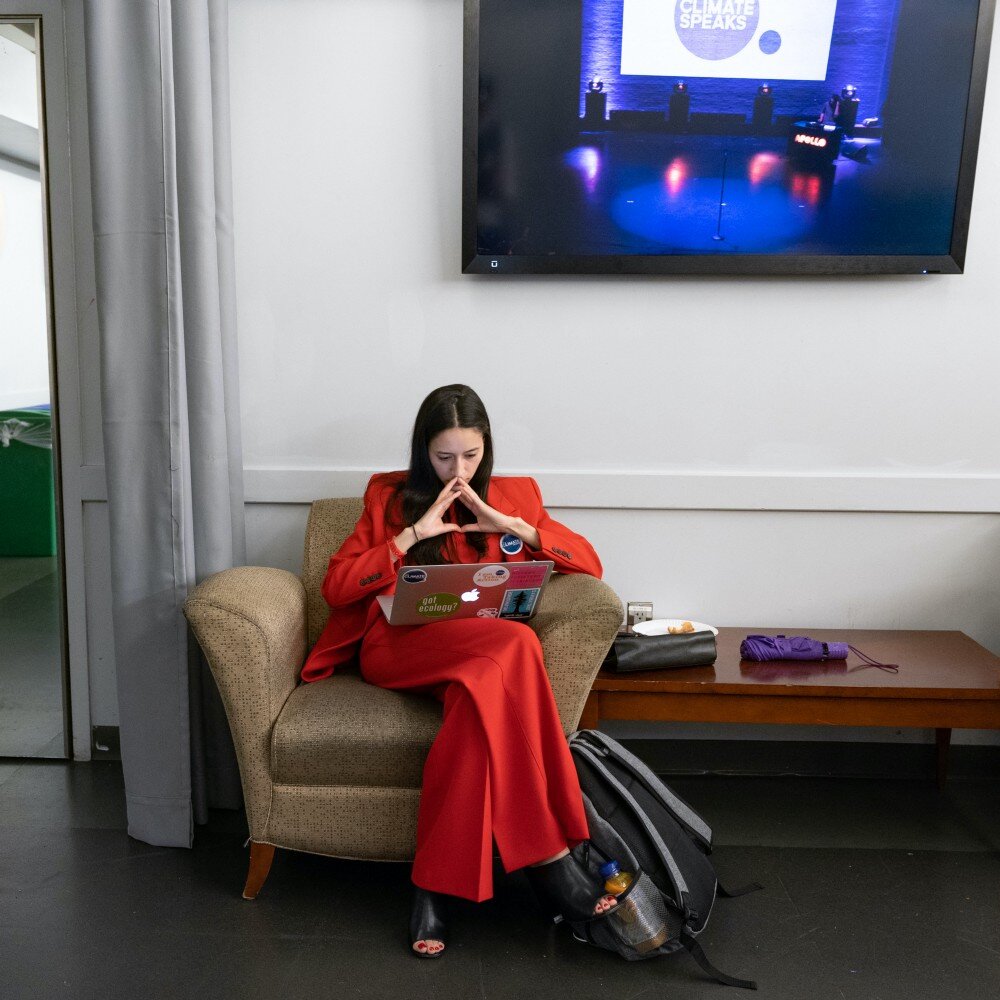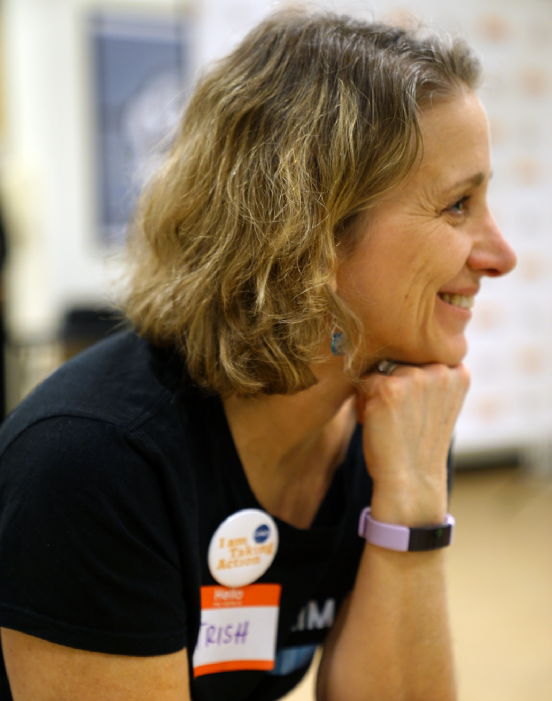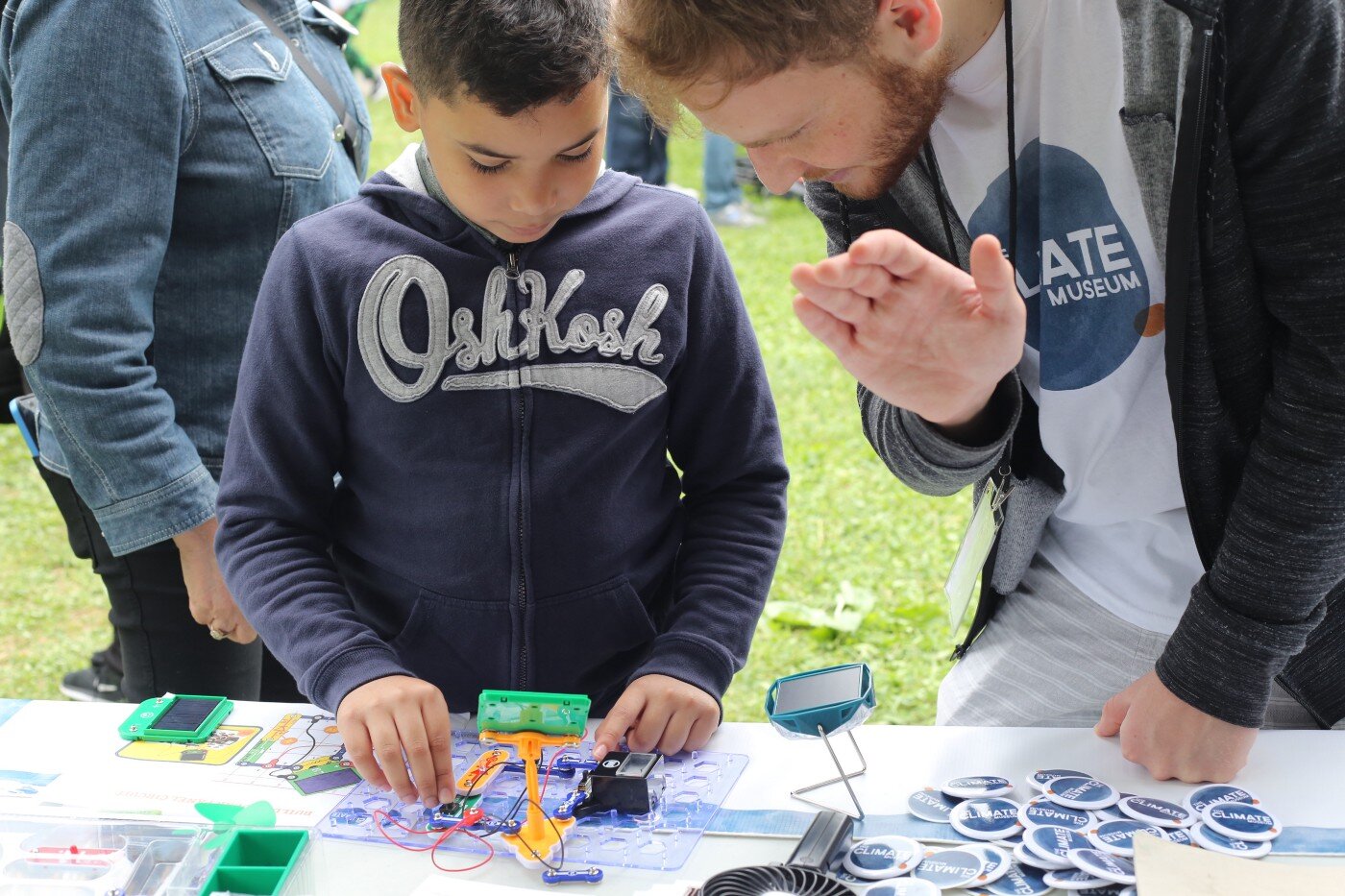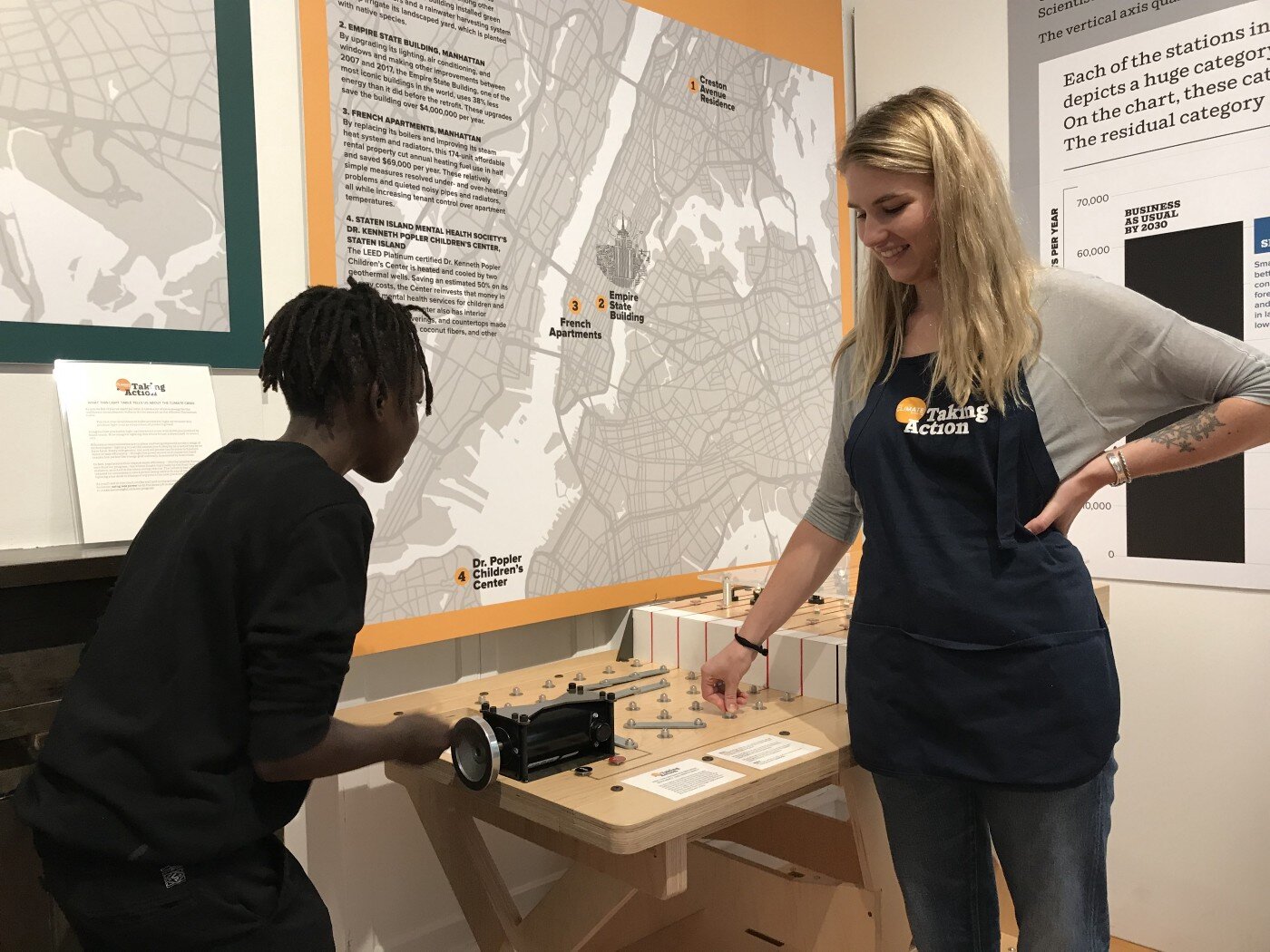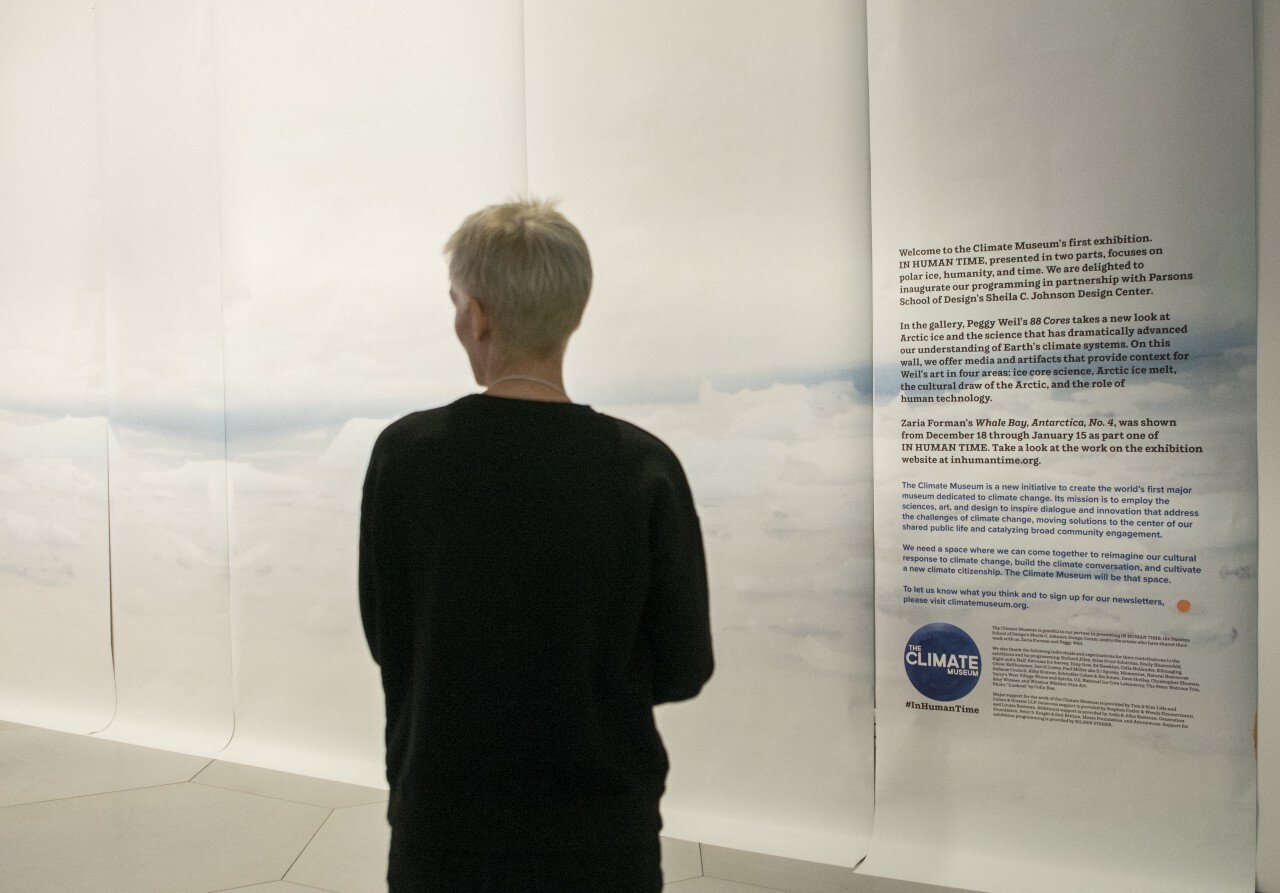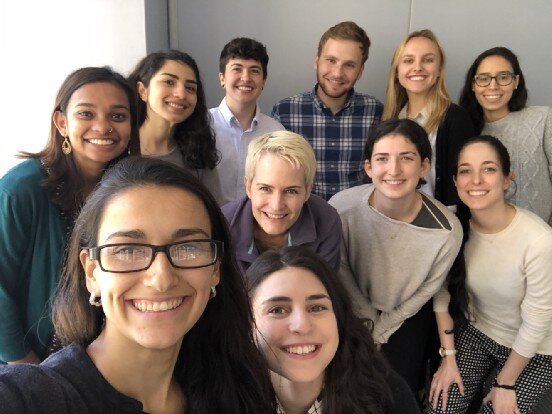Origin Stories
Meet the Climate Museum team. We came to this work through a variety of pathways. Please tell us what you think in the comments. To support the work of this extraordinary team, click here.
Photo: Rami Abouemira
Photo: Edward Watkins
Anais Reyes, Exhibitions Associate
In September 2016, after graduating with a degree in studio art and curation, I moved from Wisconsin to New York City with the goal of working in contemporary art museums. By early 2017, I was already seeing the limitations of my field. Something was missing for me.
I remember the specific moment when I realized I had to change my career. I was finishing a volunteer shift at the American Museum of Natural History and decided to take a walk through the Hall of Biodiversity. I sat in front of a short film playing in the darkest corner of the already dimly lit room. As I watched grainy shots of nature overlaid with a narration by Tom Brokaw (I swear the video had to have been made in the ’80s or ‘90s), I was engrossed. I was moved. It was then — on this Sunday afternoon, sitting all by myself in this dark corner, watching an amusingly low-res video — that I realized that the natural world inspired me more than anything else. I knew that I would not be satisfied until I made it my career to understand and share the value and beauty of nature. The video closed with a segment discussing humankind’s impact on the Earth, after which, I got up and went home.
In the following months, I dove into researching what I had to do to make my new career happen. I remember being worried about climate change — a worry exacerbated by the 2016 election, Trump pulling us out of the Paris Agreement, and the constant barrage of climate news. It was while sitting at my desk at work (an internship at a contemporary art institution) that I googled “climate change museum” — a shot in the dark, I figured, but I had to start somewhere. To my astonishment, I found that only one existed in the US, and it was in NYC… and they were looking for interns. I thought, “I wonder if I’ll look back on this day and remember it as the first step toward something big…”
Photo: Sari Goodfriend
Rachel Lit, Youth Arts Coordinator
I first found the museum through a search for museum internships on Handshake, the college version of LinkedIn, when looking for an internship for my Spring semester of my senior year of college. When I saw the posting by the Climate Museum, I jumped at the chance. It seemed like an opportunity that would be more than an internship cataloguing artifacts and leading tours; it seemed like a chance to combine my passion for social activism and my interest in a career in cultural institutions.
What I thought would be a fun, easy introduction to the world of museums turned into so much more. Over the course of that spring semester I learned that the climate crisis is vast and encompassing beyond what I had ever imagined. I had always cared about environmental issues in a vague way, but had never taken the time to educate myself about the severity of climate change, nor its intersectional implications. Interning at the museum was an eye-opening experience that woke me up to the urgency of the climate crisis and completely changed me as a person.
During my internship I had the privilege of working on the inaugural season of Climate Speaks. I have been a writer and a lover of literature my entire life, so it was an incredibly special experience for me to work on this program that combined creative writing and social activism. From talking with students during their lunch periods at NYC high schools, to reading students’ submissions, to handing out tickets at the final performance at the Apollo Theater, working on Climate Speaks was the highlight of my internship.
A few months after I graduated from college, I was offered a position at the museum as its Youth Arts Coordinator. Once again, I jumped at the chance.
Photo: Sari Goodfriend
Darian Dauchan, Climate Speaks Lead Teaching Artist
When Miranda reached out to me last year to consult and host last year’s Climate Speaks event at the legendary Apollo Theater it was a no brainer. I’m a Harlemite currently residing in Sugar Hill and a poet known for tackling current events. I was the founder of The Spoken Word Almanac project, which was a poetry collective that created poems in response to current events for a year-in-review show. Think Daily Show meet Def Poetry Jam. I’m also a teaching artist for The Brooklyn Academy of Music and mentor for Urban Word NYC. Needless to say, Climate Speaks was right up my alley and a natural extension of my work as an artist and educator. The night at the Apollo was electric. The young people were bold, fearless, inspiring, and deeply compelling. It was a delight to see them encourage one another and to solidify friendships that continue today.
So, when Miranda asked me to be the Lead Teaching Artist this year, the response was “of course.” The Climate Museum is an organization that aligns with my sensibilities as a socially conscious artist, activist, and humanitarian. And Climate Speaks combines my strengths as an educator and an artist who believes in art that speaks to the present, that reflects our times, where we’ve been, where we are now, and where we’re going. Art with a purpose. Art as edutainment. I’m grateful to assist in making this program a strong platform for young people to strive to be their best. To become leaders and storytellers that awaken and move the populace towards action. Their voices and their stories are important, vital, and necessary for saving the world…literally.
Photos: Sari Goodfriend
Saskia Randle, Arts Marketing Coordinator
In search of a summer internship as a college junior, and slightly uncertain about where my crazy combination of urban studies, architecture, environmental science, and art history classes was leading me, I conducted a search with some combination of the words “museum” “environment” “science” “art” “design”… I can’t be quite sure! (Now working on SEO for the Museum, I wish I knew!) I do know that whatever the combination was, it led me to the Climate Museum.
I immediately loved the idea. I was shocked that it existed, and equally confused that such a museum didn’t exist already. I was curious.
After scrolling through the website, I noticed that my climate professor, Gisela Winckler, who is an isotope geochemist, was listed as an advisory council member for the museum. So, one day after class, I asked her what she knew. She said “I love the work they are doing at the Climate Museum!” and continued from there.
It would be an understatement now to say I am grateful to have joined the team that summer. I am so happy every day to be able to repeat Gisela’s words (with minor adjustment) that I love the work we do at the Museum! The Climate Museum provided me a pathway of entry into climate action, and it is so fulfilling to be able to impart that to others.
Photos: Samantha Ramsahai
Tricia Brown, Senior Advisor for Education and Public Programs
“There is no Planet B.”
That clever climate march slogan has stuck with me since I first saw it several years ago. My initial response was to vote, invest, and make personal lifestyle changes in ways aligned with sustainability and climate-forward policies. But in the wake of the 2016 election, those individual steps seemed to have little consequence. Against the backdrop of an administration that decided to leave the Paris Accord and roll back critical environmental regulations, my fears about the dangers of the crisis escalated exponentially. The scope and scale of the climate crisis led me to consider how I could make more of a difference as an individual.
When I was introduced to Miranda and the Climate Museum, its mission resonated with me deeply and I immediately volunteered to help. During my career in education, I have focused on creating opportunities for students to have gratifying, impactful learning experiences. Through Climate Speaks, our high school internship program, school outreach, and more, I was able to use this experience to create pathways of climate engagement for “students” of all ages. I later began consulting for the Museum to deepen my work with an incredible team to educate and engage others to join together against this existential threat.
The more I see how eager people are for engagement, education, and collective action on the climate crisis, the more I want to do. And as a parent, I profoundly need to know that we have given everything we have to this issue before passing our planet on to the next generation.
Photo: Lisa Goulet
Bram Ziltzer, Operations Coordinator
I stumbled upon the Museum by chance, scrolling through Idealist in my search for an internship in the summer of 2018. I was a physics student at UVA, but I knew that I wanted to take my science background and apply it to a field less focused on math! In high school I was inspired by science communicators like Neil DeGrasse Tyson, Bill Nye, Richard Dawkins, and others who were taking the fascinating teachings of science and giving them to a wide audience. They also showed me the real problems science illiteracy poses for our future.
On top of that, I have a great love for theater. I love that dozens of like-minded individuals work for weeks and months to create a final production seen by an audience. The prosocial nature of theater prominently manifested the incredible work that a dedicated group of people can accomplish.
When I found the listing for a summer internship at the Climate Museum, I knew I could combine my science background with my desire to engage with the public. A huge bonus was knowing that I could work on the frontlines of a looming existential threat to make a positive impact.
Photo: Edward Watkins (Left), Maddi Kuras (Right)
Maggie O’Donnell, Online Program Coordinator
There are arguably many ways I could talk about how I came to work at the Climate Museum, but in our current context this story seems especially relevant.
In college I majored in Religion and Environmental Studies, which I found fascinating but which offered very little in terms of a straightforward career path. For my senior thesis I decided to write about hospice chaplains and how they work to reshape a patient’s sense of hope and meaning with end-of-life care. By March I was beginning to see the ways the lessons I was learning from my interviews with hospice chaplains could be used to combat my own sense of hopelessness with regard to the climate crisis. It was around this time that I interviewed for the Climate Museum’s summer internship with our Executive Director Miranda Massie (the internship coordinator I was supposed to speak with was stuck on the subway). In our conversation, Miranda and I discussed how both the arts and museum programming offer avenues through which individuals regain a sense of rational optimism that can lead to action. That summer I had the chance to see first hand what she meant.
I am happy to report that working at the Climate Museum has been the best medicine for my sense of hopelessness. Through conversations with visitors and our high school interns I became aware of the strength and potential within our communities to create systemic changes and bring about a brighter future for our planet. Even now as our ‘new normal’ begins to set in and brings with it more challenges than anyone could anticipate, I look forward to seeing the ways the Museum continues to serve as a space (be it physical or virtual) for individuals to learn, reflect, and take action together.
Photo: Sari Goodfriend (Left), Samantha Ramsahai (Right)
Trace DePass, Teaching Artist in Residence
As I was editing Scholastic’s Best Teen Writing of 2017, I ran across an essay called “On Ableism”, which centered furthering our political discourse on disability during the climate crisis. It changed me. I can’t think of a crisis without first thinking of the people who can’t be mobile within it or those with least access to resources or affordable, sustainable measures to keep themselves alive. Specific low income areas are designed to be segregated and sacrificed in the case of a natural disaster, which makes me think of my stomping grounds: Southeast Queens. An area likely to flood, likely to endure a heat wave, the current US epicenter for coronavirus, more than any other place in the city, despite the borough’s having both of NYC’s airports.
In 2018, I was asked to perform & help lead a climate piece alongside 5 other young poets to investment groups focused on environmental solutions. I had also been a teaching artist with Urban Word NYC for a few years. After seeing our work, Miranda was gracious to hire me to help launch and mentor for Climate Speaks. Miranda’s civil rights activist work had also attracted me to the Climate Museum. My inquiry became, “How can we create eco-poetics pedagogy that affirms the voices of the youth while acknowledging disparities in climate crisis impact?” I believe the young writers of Climate Speaks drove the question forward both on and off the stage. I’m glad to be a reference and resource for them, and I’m proud to have exchanged words with those whom the Climate Museum has galvanized around climate justice. I’m happy to keep the intersecting conversations going.
Amy Sutton, Curatorial Intern
I grew up in Portland, Oregon, which, while still a city, has a deep and close connection with nature. Many people from the Pacific Northwest link their identities to the forests, mountains, and beaches that we are so fortunate to have easy access to. I felt the same, and took advantage of being able to enjoy beautiful lakes, rivers, wooded hikes, and freezing cold beach trips (regardless of the season) nearly any time.
Along with that connection to nature comes a deep respect for it. You don’t have to remind Oregonians to Pack it Out, leave no trace, or stay on the path to avoid eroding the forests. You don’t have to remind us to reduce, reuse, or recycle because that’s been ingrained in our psyches since elementary school. In Oregon, we love our nature, so we treat it well.
It’s more difficult to maintain that connection to nature in New York City. Additionally, as the climate crisis becomes more dire every day, I began to feel the need to participate in something larger than myself. Recycling obsessively means less when large corporations and fossil fuel industries continue to exploit our natural resources and pump pollutants into our air, ground, and sea with abandon.
When I learned about the Climate Museum through my Museum Studies program at New York University, I thought it was the perfect vessel through which to communicate the situation we are in to a broad audience, inspiring activism and positive change through exhibitions and many other programs where we get to engage with all types of people about climate change. I applied for an internship in the fall of 2019, and I’ve been here ever since!
Photo: Sari Goodfriend (R is on the left)
R Merriman-Goldring, Grantwriter
My Climate Museum origin story starts with the first museums I fell in love with — the curved walls and thoughtful curation at the Hirshhorn Museum, and the four Rothko paintings and one quiet bench in the Phillips Museum.
My story restarts with a college class on art and ecology: writing my first research grant, hundreds of hours spent combing through books learning about environmental art, encountering Eve Mosher’s HighWaterLine, a participatory public art piece on sea level rise, and interviewing Eve for my research project.
In 2015, the Climate Museum began to project a public presence as a space bringing together the power of museums and art-based environmental communication. I was excited to see Eve on the Museum’s advisory council, and reached out to her sending her a list of everything I could possibly do to help build a climate museum.
Long story short, I started trying to get involved with the Museum in October 2015, and with persistence and some luck, in 2017, was hired as a Summer Fellow. I have been involved in the Museum since then, mostly in a development and grantwriting capacity, helping secure the resources we need to grow and meet the challenges posed by the intensifying climate crisis.
I am a part of the Climate Museum team because I believe in the power of collective action. The Climate Museum is one my two main homes; I am also an organizer and grassroots fundraiser with Philly Thrive, a community group demanding environmental justice in South Philadelphia — home to the East Coast’s largest and oldest oil refinery, which we just got shut down. I find so much joy in getting to work in both spaces and am moved by the ways that by taking robust justice-focus action on climate, we can build towards a world that is more climate-safe, as well as more racially just, accessible, and liberated. I came to the Museum drawn to what we can build together, and I am here today, still electrified.
Photos: Sari Goodfriend
Photos: Sari Goodfriend
Miranda Massie, Director
The idea of a climate museum was dropped into my mind by a mysterious outside force in late 2012. (I should say that I don’t believe in any of the usual outside forces — just luck.) The immediate context has been recounted in stories in the New Yorker and the New York Times, so here I’ll talk about something earlier, a little prehistory.
It’s a story about denial and avoidance — thus very much a climate story. It dates back to the era when Netflix sent you the DVDs on your queue in order, distributing them to you in sequence as you worked your way through the list you had negotiated with yourself or your housemates and returned them to Netflix. The DVDs were moved back and forth by horse-drawn wagons.
As soon as An Inconvenient Truth was released on DVD, I moved it up to the top of my list. I felt immediately that this was a moment of reckoning on the key question. I don’t remember thinking about climate change except in passing, nervously, before then.
The film arrived. I pulled it out of the outer envelope. They were red, which lives on in the brand identity. Then I left it in the sleeve and held onto it for more than a year without watching it. Every month I paid my membership fee, and every month I kept the DVD without watching it, rather than sending it back to get the next movie in my queue. In effect, I bought the DVD several times over. This holding pattern astounded and exasperated the man I was living with. But I was committed.
I was paying not to watch the movie: not to reckon with the key question.
Perhaps this denial and avoidance, accumulated over several more years, came together as that mysterious “outside” force that dropped the Climate Museum into my head, and caused me to start working on climate, when I finally did, with intense pent-up energy.
I’ve had the wild luck of deeply rewarding work throughout my career. But nothing close to working on this fight, in this way, with the extraordinary people you’ve just read about. Has it also been much harder? For sure. But the balance sheet is, well, out of balance.
This is all to say, if there has been a voice in your head telling you that climate is the question and that some part of you wants to do more on it, I hope you can listen to that voice without self-blame. No matter what your lag has been or how it has expressed itself — probably less absurdly than clinging to an unwatched DVD while batting away your partner’s impeccable logic — pretty much everyone has a lag and that doesn’t matter. What matters is what we do together, now. What you choose to do can be a fairly small part of your life or a large chunk of it. Either way, you will be exposed to excruciating information and also to the most inspiring prospects of human transformation you can imagine.
In the book we made about our first exhibition, In Human Time, which presented the work of two brilliant artists, Zaria Forman and Peggy Weil, as a mediation on polar ice loss, humanity, and time scales, we quoted one of the people in my Venn diagram overlap zone of favorite writers and personal heroes, James Baldwin. He was writing about the struggle against racism and for our common humanity, but I believe it applies to the climate struggle too: “[t]here is never a time in the future in which we will work out our salvation. The challenge is in the moment; the time is always now.”
Join us. You won’t regret it.
Photos: Colin Clark (Top Left), Rami Abouemira (Bottom Right)

